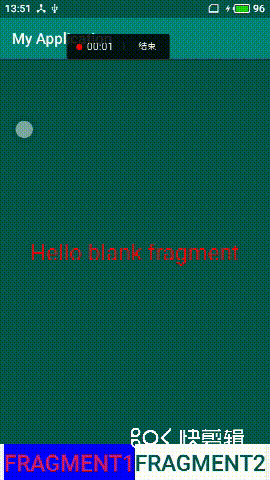Android Fragment的静态注册和动态注册创建步骤
一、fragment静态注册创建方法及步骤
1.创建一个StaticFragment.java文件继承Fragment类和一个static_fragment.xml文件完成fragment的布局。在StaticFragment.java中重载onCreateView(……)方法,通过调用inflater.inflate(……)方法并传入布局资源ID生成fragment的视图资源,并绑定static_fragment.xml中的相关组件然后实现其功能。实现代码如下:
static_fragment.xml
<?xml version="1.0" encoding="utf-8"?> <LinearLayout xmlns:android="http://schemas.android.com/apk/res/android" xmlns:tools="http://schemas.android.com/tools" android:layout_width="match_parent" android:layout_height="match_parent" tools:context=".StaticFragment" android:orientation="vertical"> <Button android:id="@+id/btn_fm" android:layout_width="match_parent" android:layout_height="wrap_content" android:text="这是fragment静态注册" android:textAllCaps="false"> </Button> <EditText android:id="@+id/et_fm" android:layout_width="match_parent" android:layout_height="wrap_content" android:hint="请输入你要改变的内容:"> </EditText> </LinearLayout>
StaticFragment.java
package com.example.myapplication;
import android.os.Bundle;
import android.view.LayoutInflater;
import android.view.View;
import android.view.ViewGroup;
import android.widget.Button;
import android.widget.EditText;
import androidx.annotation.NonNull;
import androidx.annotation.Nullable;
import androidx.fragment.app.Fragment;
public class StaticFragment extends Fragment {
private Button mBtnFm;
private EditText mEtFm;
@Nullable
@Override
public View onCreateView(@NonNull LayoutInflater inflater,
@Nullable ViewGroup container,
@Nullable Bundle savedInstanceState) {
//fragment的视图资源是直接通过调用inflater.inflate(……)方法并传入布局资源ID生成的。
View v = inflater.inflate(R.layout.static_fragment,
container,false);
mEtFm = v.findViewById(R.id.et_fm);
mBtnFm = v.findViewById(R.id.btn_fm);
mBtnFm.setOnClickListener(new View.OnClickListener() {
@Override
public void onClick(View v) {
mBtnFm.setText(mEtFm.getText().toString());
}
});
return v;
}
}
2.在主布局activity_main.xml文件中绑定fragment布局文件。
实现代码如下:
activity_main.xml
<?xml version="1.0" encoding="utf-8"?> <LinearLayout xmlns:android="http://schemas.android.com/apk/res/android" xmlns:tools="http://schemas.android.com/tools" android:layout_width="match_parent" android:layout_height="match_parent" tools:context=".MainActivity" android:orientation="vertical"> <TextView android:layout_width="match_parent" android:layout_height="wrap_content" android:text="这是主布局" android:textColor="@color/colorAccent" android:textSize="30sp"> </TextView> <TextView android:layout_width="match_parent" android:layout_height="wrap_content" android:text="下面是fragment的布局" android:textColor="@color/colorPrimaryDark" android:textSize="30sp"> </TextView> <fragment android:id="@+id/static_fm" android:name="com.example.myapplication.StaticFragment" android:layout_width="match_parent" android:layout_height="wrap_content"> </fragment> </LinearLayout>
注意:布局文件中加fragment节点,name属性必须填写完整的路径
MainActivity.java
package com.example.myapplication;
import androidx.appcompat.app.AppCompatActivity;
import android.os.Bundle;
public class MainActivity extends AppCompatActivity {
@Override
protected void onCreate(Bundle savedInstanceState) {
super.onCreate(savedInstanceState);
setContentView(R.layout.activity_main);
}
}
演示:

二、fragment动态注册创建方法及步骤
1.新建一个项目,创建2个Fragment继承类分别为MyFragment1.java和MyFragment2.java,然后创建2个布局文件分别为fragment1.xml和fragment2.xml.详细代码如下:
fragment1.xml
<?xml version="1.0" encoding="utf-8"?> <LinearLayout xmlns:android="http://schemas.android.com/apk/res/android" xmlns:tools="http://schemas.android.com/tools" android:layout_width="match_parent" android:layout_height="match_parent" tools:context=".MyFragment1" android:gravity="center" android:background="@color/colorPrimaryDark"> <TextView android:layout_width="wrap_content" android:layout_height="match_parent" android:gravity="center" android:text="@string/hello_blank_fragment" android:textSize="30sp" android:textAllCaps="false" android:textColor="#F70505"> </TextView> </LinearLayout>
MyFragment1.java
package com.example.myapplication;
import android.content.Context;
import android.net.Uri;
import android.os.Bundle;
import androidx.fragment.app.Fragment;
import android.view.LayoutInflater;
import android.view.View;
import android.view.ViewGroup;
public class MyFragment1 extends Fragment {
@Override
public View onCreateView(LayoutInflater inflater, ViewGroup container,
Bundle savedInstanceState) {
// Inflate the layout for this fragment
return inflater.inflate(R.layout.fragment1, container, false);
}
}
fragment2.xml
<?xml version="1.0" encoding="utf-8"?> <LinearLayout xmlns:android="http://schemas.android.com/apk/res/android" xmlns:tools="http://schemas.android.com/tools" android:layout_width="match_parent" android:layout_height="match_parent" tools:context=".MyFragment2" android:gravity="center" android:background="@color/colorAccent"> <TextView android:layout_width="wrap_content" android:layout_height="match_parent" android:gravity="center" android:text="@string/hello_blank_fragment" android:textSize="30sp" android:textAllCaps="false" android:textColor="#03FAE3"> </TextView> </LinearLayout>
MyFragment2.java
package com.example.myapplication;
import android.os.Bundle;
import androidx.fragment.app.Fragment;
import android.view.LayoutInflater;
import android.view.View;
import android.view.ViewGroup;
public class MyFragment2 extends Fragment {
@Override
public View onCreateView(LayoutInflater inflater,
ViewGroup container,
Bundle savedInstanceState) {
// Inflate the layout for this fragment
return inflater.inflate(R.layout.fragment2, container, false);
}
}
上述代码与静态创建的区别不大。
2.以代码的形式将fragment添加到activity需要在activity里直接调用FragmentManager。
FragmentManager fm = getSupportFragmentManager();
然后通过代码块:
FragmentTransaction ts = fm.beginTransaction(); Fragment mfg1 = new MyFragment1(); ts.add(R.id.fragment_container,mfg1); ts.commit();
提交一个fragment事务。其核心是ts.add(……)方法。
详细代码如下:
activity_main.xml:
<?xml version="1.0" encoding="utf-8"?> <RelativeLayout xmlns:android="http://schemas.android.com/apk/res/android" xmlns:tools="http://schemas.android.com/tools" android:layout_width="match_parent" android:layout_height="match_parent" tools:context=".MainActivity"> <LinearLayout android:id="@+id/linear" android:layout_width="match_parent" android:layout_height="wrap_content" android:gravity="center" android:layout_alignParentBottom="true"> <Button android:id="@+id/btn_dy1" android:layout_width="wrap_content" android:layout_height="wrap_content" android:text="fragment1" android:textColor="@color/colorAccent" android:textSize="30sp"> </Button> <Button android:id="@+id/btn_dy2" android:layout_width="wrap_content" android:layout_height="wrap_content" android:text="fragment2" android:textColor="@color/colorPrimaryDark" android:textSize="30sp"> </Button> </LinearLayout> <FrameLayout android:id="@+id/fragment_container" android:layout_width="match_parent" android:layout_height="match_parent" android:layout_above="@id/linear"> </FrameLayout> </RelativeLayout>
注意:fragment模块一般用FrameLayout布局承载
MainActivity.java
package com.example.myapplication;
import androidx.appcompat.app.AppCompatActivity;
import androidx.fragment.app.Fragment;
import androidx.fragment.app.FragmentManager;
import androidx.fragment.app.FragmentTransaction;
import android.os.Bundle;
import android.view.View;
import android.widget.Button;
public class MainActivity extends AppCompatActivity implements View.OnClickListener {
private Button mBtnDy1;
private Button mBtnDy2;
FragmentManager fm;
Fragment mfg1;
Fragment mfg2;
@Override
protected void onCreate(Bundle savedInstanceState) {
super.onCreate(savedInstanceState);
setContentView(R.layout.activity_main);
fm = getSupportFragmentManager();
mBtnDy1 = findViewById(R.id.btn_dy1);
mBtnDy2 = findViewById(R.id.btn_dy2);
mBtnDy1.setOnClickListener(this);
mBtnDy2.setOnClickListener(this);
}
@Override
public void onClick(View v) {
clearSelection();//清除按钮状态
FragmentTransaction ts = fm.beginTransaction();
hideFragments(ts);
switch (v.getId()){
case R.id.btn_dy1:
mBtnDy1.setBackgroundColor(0xff0000ff);
if(mfg1 == null){
mfg1 = new MyFragment1();
ts.add(R.id.fragment_container,mfg1);
}else {
ts.show(mfg1);
}
break;
case R.id.btn_dy2:
mBtnDy2.setBackgroundColor(0xff0000ff);
if(mfg2 == null){
mfg2 = new MyFragment2();
ts.add(R.id.fragment_container,mfg2);
}else {
ts.show(mfg2);
}
break;
default:
break;
}
ts.commit();
}
// 将所有的Fragment都置为隐藏状态。
private void hideFragments(FragmentTransaction transaction) {
if (mfg1 != null) {
transaction.hide(mfg1);
}
if (mfg2 != null) {
transaction.hide(mfg2);
}
}
// 清除掉所有的选中状态。
private void clearSelection() {
mBtnDy1.setBackgroundColor(0xffffffff);
mBtnDy2.setBackgroundColor(0xffffffff);
}
}
演示:

总结
以上所述是小编给大家介绍的Android Fragment的静态注册和动态注册创建步骤,希望对大家有所帮助!
您可能感兴趣的文章:
- android-fragment的静态和动态注册。
- Android -- fragment, 动态创建,创建选项卡,静态创建,fragment之间的通信
- Android Fragment 动态、静态切换
- Android开发4: Notification编程基础、Broadcast的使用及其静态注册、动态注册方式
- Android 第十九课 大喇叭--广播机制----动态注册监听网络变化与静态注册实现开机启动
- 【译】用Fragment创建动态的界面布局(附Android示例代码)
- Android导入design.v4包,Fragment生命周期,静态/动态加载
- android 动态创建Fragment
- Fragment的静态创建、动态创建
- Android 接收系统发送的广播,动态注册和静态注册
- 深入Android中BroadcastReceiver的两种注册方式(静态和动态)详解
- 【转】用Fragment创建动态的界面布局(附Android示例代码) - 小吉吉
- Android进阶之路 - BroadcaseReceiver(自定义广播、有序广播、无序广播、广播拦截、动态注册、静态注册)的详细使用方式
- android 静态创建fragment
- android 注册静态广播接收器VS注册动态广播接收器
- Android深入理解JNI(一)JNI原理与静态、动态注册
- Android-动态加载和静态加载Fragment
- android 4.4 动态注册+静态注册电话短信广播后收到两次onReceive回调的问题
- Android 动态创建Fragment
- Android开发4:Notification、Broadcast及其静态注册、动态注册方式
